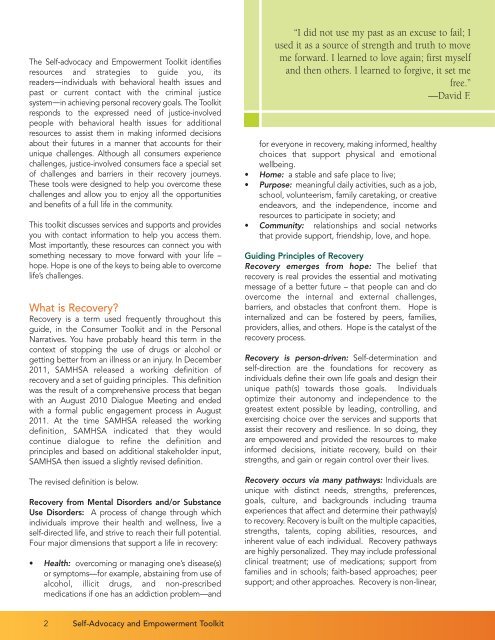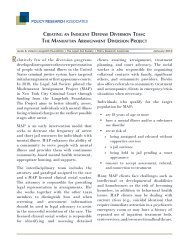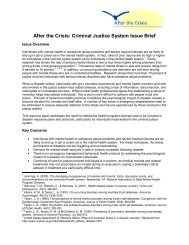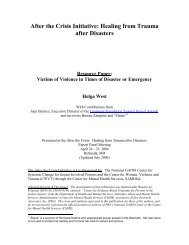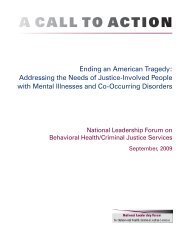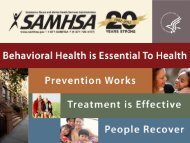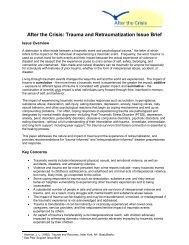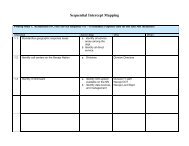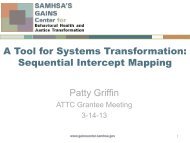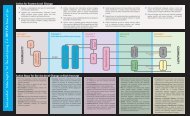Self-Advocacy and Empowerment Toolkit - STAR Center
Self-Advocacy and Empowerment Toolkit - STAR Center
Self-Advocacy and Empowerment Toolkit - STAR Center
Create successful ePaper yourself
Turn your PDF publications into a flip-book with our unique Google optimized e-Paper software.
The <strong>Self</strong>-advocacy <strong>and</strong> <strong>Empowerment</strong> <strong>Toolkit</strong> identifies<br />
resources <strong>and</strong> strategies to guide you, its<br />
readers―individuals with behavioral health issues <strong>and</strong><br />
past or current contact with the criminal justice<br />
system―in achieving personal recovery goals. The <strong>Toolkit</strong><br />
responds to the expressed need of justice-involved<br />
people with behavioral health issues for additional<br />
resources to assist them in making informed decisions<br />
about their futures in a manner that accounts for their<br />
unique challenges. Although all consumers experience<br />
challenges, justice-involved consumers face a special set<br />
of challenges <strong>and</strong> barriers in their recovery journeys.<br />
These tools were designed to help you overcome these<br />
challenges <strong>and</strong> allow you to enjoy all the opportunities<br />
<strong>and</strong> benefits of a full life in the community.<br />
This toolkit discusses services <strong>and</strong> supports <strong>and</strong> provides<br />
you with contact information to help you access them.<br />
Most importantly, these resources can connect you with<br />
something necessary to move forward with your life –<br />
hope. Hope is one of the keys to being able to overcome<br />
life’s challenges.<br />
What is Recovery<br />
Recovery is a term used frequently throughout this<br />
guide, in the Consumer <strong>Toolkit</strong> <strong>and</strong> in the Personal<br />
Narratives. You have probably heard this term in the<br />
context of stopping the use of drugs or alcohol or<br />
getting better from an illness or an injury. In December<br />
2011, SAMHSA released a working definition of<br />
recovery <strong>and</strong> a set of guiding principles. This definition<br />
was the result of a comprehensive process that began<br />
with an August 2010 Dialogue Meeting <strong>and</strong> ended<br />
with a formal public engagement process in August<br />
2011. At the time SAMHSA released the working<br />
definition, SAMHSA indicated that they would<br />
continue dialogue to refine the definition <strong>and</strong><br />
principles <strong>and</strong> based on additional stakeholder input,<br />
SAMHSA then issued a slightly revised definition.<br />
The revised definition is below.<br />
Recovery from Mental Disorders <strong>and</strong>/or Substance<br />
Use Disorders: A process of change through which<br />
individuals improve their health <strong>and</strong> wellness, live a<br />
self-directed life, <strong>and</strong> strive to reach their full potential.<br />
Four major dimensions that support a life in recovery:<br />
• Health: overcoming or managing one’s disease(s)<br />
or symptoms—for example, abstaining from use of<br />
alcohol, illicit drugs, <strong>and</strong> non-prescribed<br />
medications if one has an addiction problem—<strong>and</strong><br />
“I did not use my past as an excuse to fail; I<br />
used it as a source of strength <strong>and</strong> truth to move<br />
me forward. I learned to love again; first myself<br />
<strong>and</strong> then others. I learned to forgive, it set me<br />
free.”<br />
—David F.<br />
for everyone in recovery, making informed, healthy<br />
choices that support physical <strong>and</strong> emotional<br />
wellbeing.<br />
• Home: a stable <strong>and</strong> safe place to live;<br />
• Purpose: meaningful daily activities, such as a job,<br />
school, volunteerism, family caretaking, or creative<br />
endeavors, <strong>and</strong> the independence, income <strong>and</strong><br />
resources to participate in society; <strong>and</strong><br />
• Community: relationships <strong>and</strong> social networks<br />
that provide support, friendship, love, <strong>and</strong> hope.<br />
Guiding Principles of Recovery<br />
Recovery emerges from hope: The belief that<br />
recovery is real provides the essential <strong>and</strong> motivating<br />
message of a better future – that people can <strong>and</strong> do<br />
overcome the internal <strong>and</strong> external challenges,<br />
barriers, <strong>and</strong> obstacles that confront them. Hope is<br />
internalized <strong>and</strong> can be fostered by peers, families,<br />
providers, allies, <strong>and</strong> others. Hope is the catalyst of the<br />
recovery process.<br />
Recovery is person-driven: <strong>Self</strong>-determination <strong>and</strong><br />
self-direction are the foundations for recovery as<br />
individuals define their own life goals <strong>and</strong> design their<br />
unique path(s) towards those goals. Individuals<br />
optimize their autonomy <strong>and</strong> independence to the<br />
greatest extent possible by leading, controlling, <strong>and</strong><br />
exercising choice over the services <strong>and</strong> supports that<br />
assist their recovery <strong>and</strong> resilience. In so doing, they<br />
are empowered <strong>and</strong> provided the resources to make<br />
informed decisions, initiate recovery, build on their<br />
strengths, <strong>and</strong> gain or regain control over their lives.<br />
Recovery occurs via many pathways: Individuals are<br />
unique with distinct needs, strengths, preferences,<br />
goals, culture, <strong>and</strong> backgrounds including trauma<br />
experiences that affect <strong>and</strong> determine their pathway(s)<br />
to recovery. Recovery is built on the multiple capacities,<br />
strengths, talents, coping abilities, resources, <strong>and</strong><br />
inherent value of each individual. Recovery pathways<br />
are highly personalized. They may include professional<br />
clinical treatment; use of medications; support from<br />
families <strong>and</strong> in schools; faith-based approaches; peer<br />
support; <strong>and</strong> other approaches. Recovery is non-linear,<br />
2 <strong>Self</strong>-<strong>Advocacy</strong> <strong>and</strong> <strong>Empowerment</strong> <strong>Toolkit</strong>


